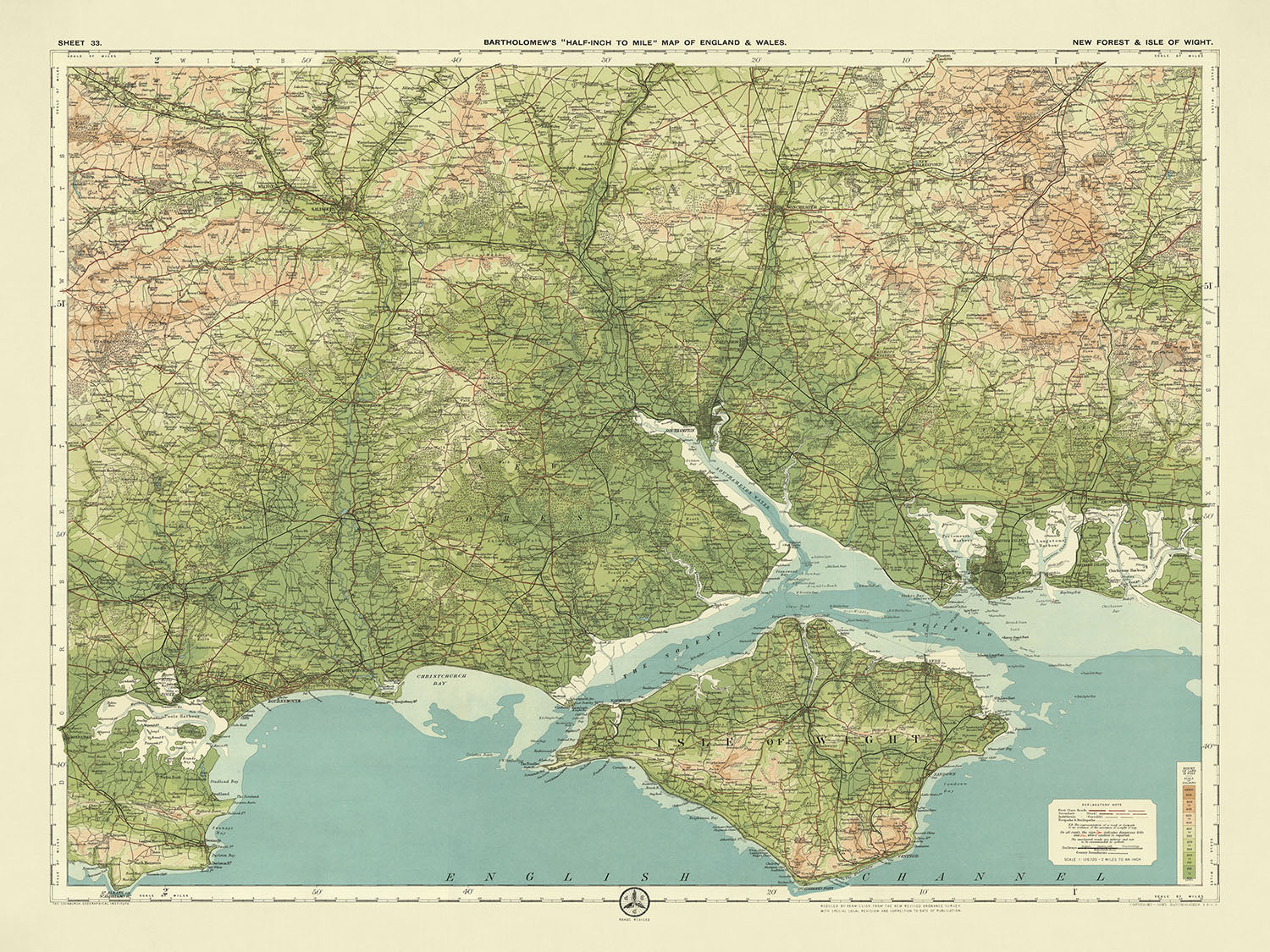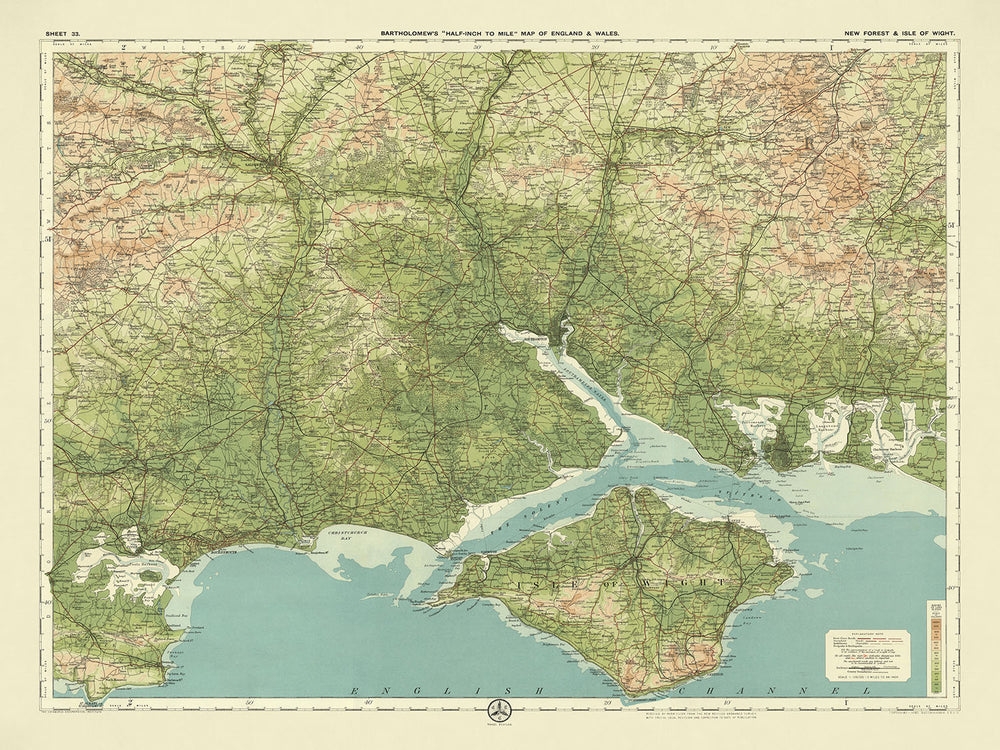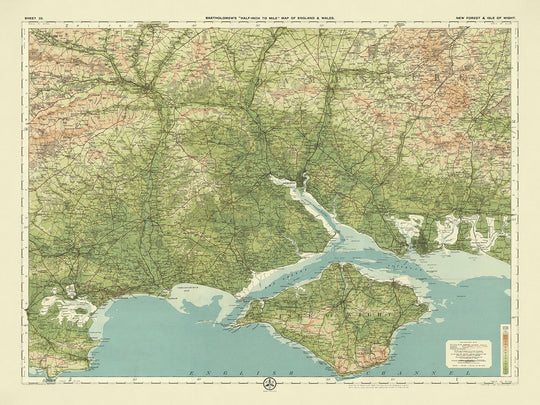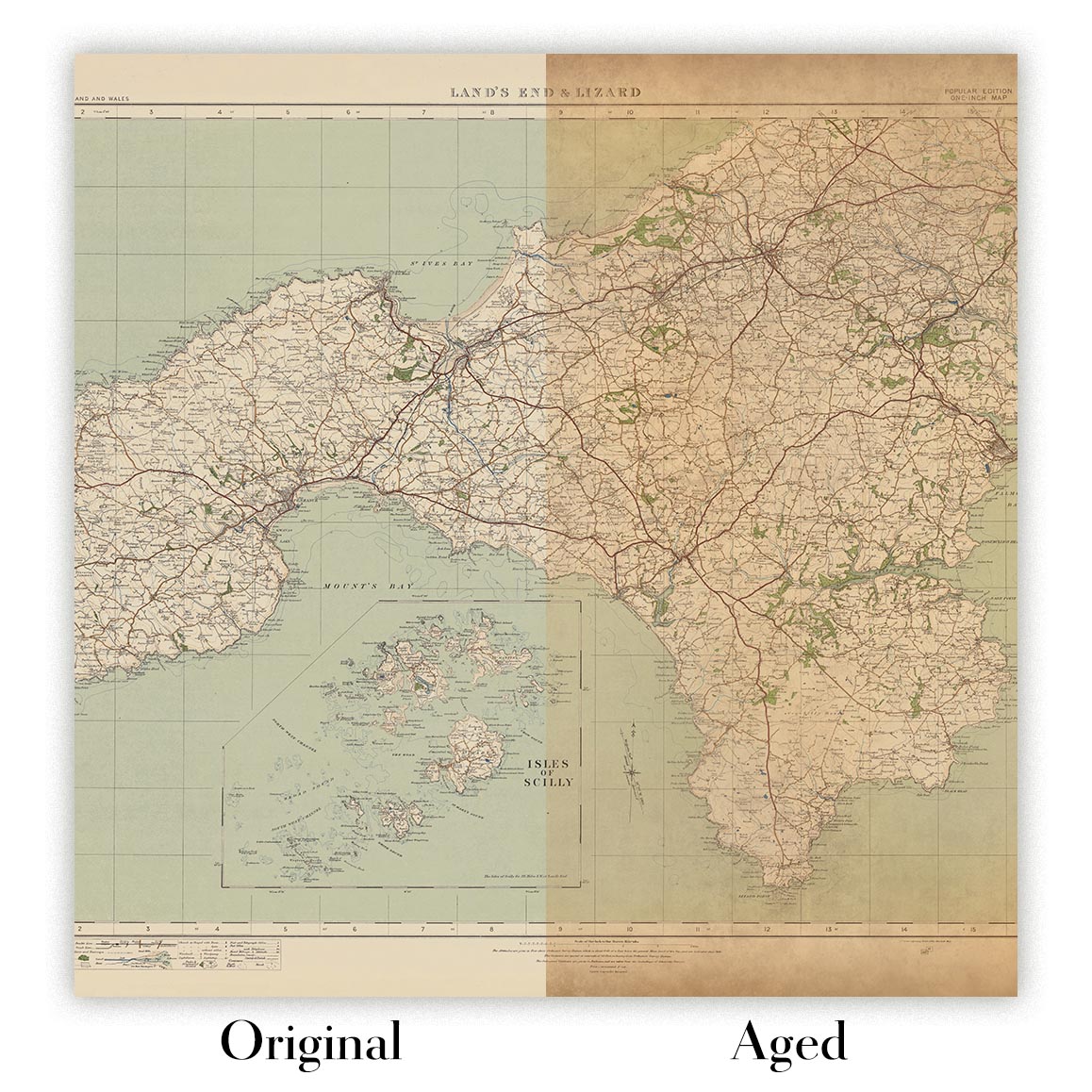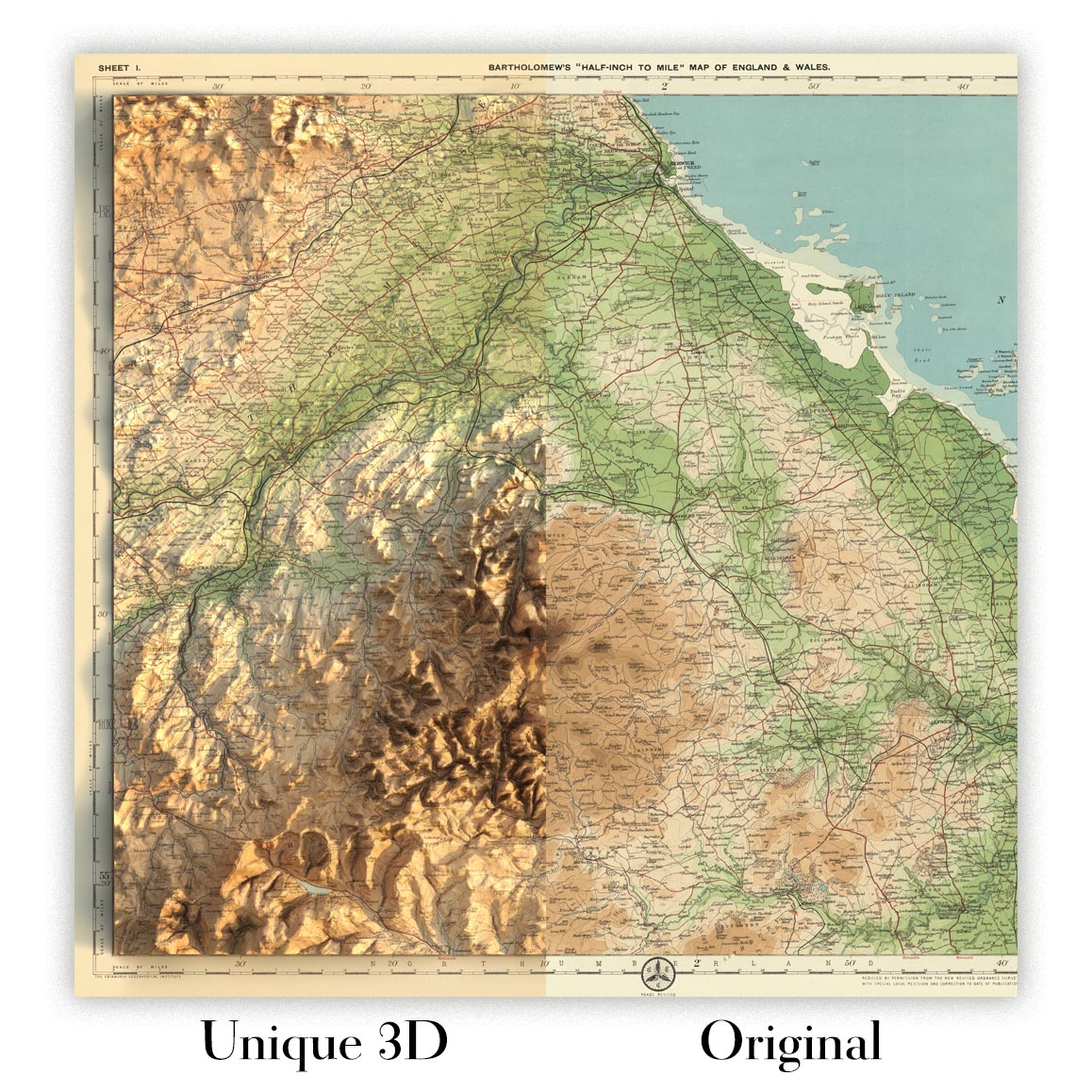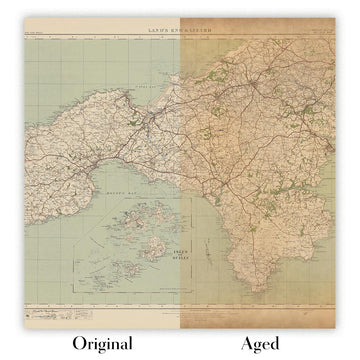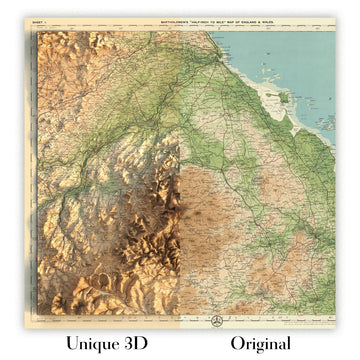- Handmade locally. No import duty or tax
- FREE Delivery by Christmas
- Love it or your money back (90 days)
- Questions? WhatsApp me any time
Own a piece of history
5,000+ 5 star reviews


Introducing the exquisite "Sheet 33 - New Forest & Isle of Wight," a masterful creation by the renowned cartographer JG Bartholomew in 1901. This map, part of Bartholomew's flagship series, epitomizes the elegance and precision of early 20th-century cartography. Designed at a half-inch to the mile scale (1:126,720), it offers a meticulously detailed representation of the New Forest and the Isle of Wight, capturing the region's topographical nuances with a sophisticated gradation of color bands to denote varying land heights. This map is not just a navigational tool but a work of art, reflecting the era's cartographic advancements and aesthetic sensibilities.
JG Bartholomew, a distinguished Scottish cartographer, was celebrated for his innovative approach to mapmaking. His maps were highly regarded by cyclists and tourists for their clarity and attractiveness. This particular map is based on a reduced Ordnance Survey map from the same period, showcasing Bartholomew's dedication to accuracy and detail. His work has left an indelible mark on the field of cartography, and this map is a testament to his legacy, blending scientific precision with artistic beauty.
The map's design is a visual delight, with its use of different layers of color to represent landscape relief. This subtle and innovative technique allows viewers to appreciate the region's topography at a glance. The New Forest, with its extensive woodlands and heathlands, is depicted in lush greens, while the Isle of Wight is detailed with its distinctive coastal features. The map also highlights significant historical landmarks such as Beaulieu Abbey, Carisbrooke Castle, and Osborne House, offering a glimpse into the rich history of the area.
Beyond its aesthetic appeal, this map is a treasure trove of historical and geographical information. It covers an area of 18 miles from north to south and 26 miles from west to east, encompassing a diverse range of landscapes and settlements. The New Forest, now a national park, is renowned for its natural beauty and biodiversity. The Isle of Wight, with its iconic Needles Rocks and Lighthouse, Alum Bay's multi-colored cliffs, and historic fortifications like Hurst Castle and Yarmouth Castle, is a region steeped in history and natural wonders.
This map also features a detailed depiction of numerous towns and cities, including Southampton, Bournemouth, Lymington, and Newport. Each settlement is carefully marked, providing a snapshot of the region's human geography at the turn of the 20th century. The map's inclusion of significant landmarks, such as the Ventnor Botanic Garden, Newport Roman Villa, and Quarr Abbey, further enriches its historical context. Owning this map is like holding a piece of history, offering a window into the past and a deeper understanding of the region's cultural and natural heritage.
Cities and towns on this map
- Hampshire (including New Forest):
- Southampton
- Bournemouth
- Lymington
- Ringwood
- Fordingbridge
- Brockenhurst
- New Milton
- Totton
- Hythe
- Christchurch
- Romsey
- Eastleigh
- Winchester
- Salisbury
- Andover
- Fareham
- Gosport
-
Portsmouth
-
Isle of Wight:
- Newport
- Ryde
- Cowes
- East Cowes
- Sandown
- Shanklin
- Ventnor
- Yarmouth
- Freshwater
Notable Features & Landmarks
- New Forest (designated as a national park in 2005, but historically significant for its woodlands and heathlands)
- Beaulieu Abbey (historic Cistercian abbey)
- Carisbrooke Castle (historic castle on the Isle of Wight)
- Osborne House (historic royal residence on the Isle of Wight)
- Hurst Castle (historic coastal fortification)
- Needles Rocks and Lighthouse (iconic natural and man-made landmarks on the Isle of Wight)
- Yarmouth Castle (historic coastal fortification)
- Fort Victoria (historic coastal defense fort on the Isle of Wight)
- Calbourne Water Mill (historic working water mill on the Isle of Wight)
- Alum Bay (known for its multi-colored sand cliffs)
- Ventnor Botanic Garden (historically significant garden due to its unique microclimate)
- Newport Roman Villa (remains of a Roman farmhouse)
- Brading Roman Villa (well-preserved Roman site)
- Sandown Barrack Battery (historic coastal defense)
- Appuldurcombe House (historic manor house)
- Quarr Abbey (historic abbey ruins)
- St Catherine's Lighthouse (historic lighthouse)
- Highcliffe Castle (historic mansion)
- Bucklers Hard (historic shipbuilding village)
- Exbury Gardens (historic gardens)
Historical and design context
- Name of the map: Sheet 33 - New Forest & Isle of Wight
- Scale: Half-inch to the mile (1:126,720)
- Creation Date: 1901
- Mapmaker/Publisher: JG Bartholomew
- Context about the mapmaker: JG Bartholomew was a renowned Scottish cartographer and the founder of the Bartholomew mapmaking company. His work was known for its precision and aesthetic appeal, and his maps were highly regarded by cyclists and tourists.
- Design and Style:
- Landscape Relief: Utilizes different layers of color to represent landscape relief, with a subtle gradation of color bands to show land at different heights.
- Source: Based on a reduced Ordnance Survey map from the same period.
- Topics and Themes:
- Political and Physical Map: Shows both political boundaries and physical features of the landscape.
- Tourism and Cycling: Popular among cyclists and tourists for its clear and attractive design.
- Regions and Countries Shown:
- New Forest: An area in southern England known for its extensive natural woodlands and heathlands.
- Isle of Wight: An island off the southern coast of England.
- Historical Significance:
- Early 20th Century Cartography: Reflects the cartographic techniques and aesthetic preferences of the early 20th century.
- Bartholomew's Flagship Series: Part of Bartholomew's flagship series of maps, which were highly influential in the development of modern cartography.
Please double check the images to make sure that a specific town or place is shown on this map. You can also get in touch and ask us to check the map for you.
This map looks great at every size, but I always recommend going for a larger size if you have space. That way you can easily make out all of the details.
This map looks amazing at sizes all the way up to 70in (180cm). If you are looking for a larger map, please get in touch.
Please note: the labels on this map are hard to read if you order a map that is 20in (50cm) or smaller. The map is still very attractive, but if you would like to read the map easily, please buy a larger size.
The model in the listing images is holding the 18x24in (45x60cm) version of this map.
The fifth listing image shows an example of my map personalisation service.
If you’re looking for something slightly different, check out my collection of the best old maps to see if something else catches your eye.
Please contact me to check if a certain location, landmark or feature is shown on this map.
This would make a wonderful birthday, Christmas, Father's Day, work leaving, anniversary or housewarming gift for someone from the areas covered by this map.
This map is available as a giclée print on acid free archival matte paper, or you can buy it framed. The frame is a nice, simple black frame that suits most aesthetics. Please get in touch if you'd like a different frame colour or material. My frames are glazed with super-clear museum-grade acrylic (perspex/acrylite), which is significantly less reflective than glass, safer, and will always arrive in perfect condition.
This map is also available as a float framed canvas, sometimes known as a shadow gap framed canvas or canvas floater. The map is printed on artist's cotton canvas and then stretched over a handmade box frame. We then "float" the canvas inside a wooden frame, which is available in a range of colours (black, dark brown, oak, antique gold and white). This is a wonderful way to present a map without glazing in front. See some examples of float framed canvas maps and explore the differences between my different finishes.
For something truly unique, this map is also available in "Unique 3D", our trademarked process that dramatically transforms the map so that it has a wonderful sense of depth. We combine the original map with detailed topography and elevation data, so that mountains and the terrain really "pop". For more info and examples of 3D maps, check my Unique 3D page.
For most orders, delivery time is about 3 working days. Personalised and customised products take longer, as I have to do the personalisation and send it to you for approval, which usually takes 1 or 2 days.
Please note that very large framed orders usually take longer to make and deliver.
If you need your order to arrive by a certain date, please contact me before you order so that we can find the best way of making sure you get your order in time.
I print and frame maps and artwork in 23 countries around the world. This means your order will be made locally, which cuts down on delivery time and ensures that it won't be damaged during delivery. You'll never pay customs or import duty, and we'll put less CO2 into the air.
All of my maps and art prints are well packaged and sent in a rugged tube if unframed, or surrounded by foam if framed.
I try to send out all orders within 1 or 2 days of receiving your order, though some products (like face masks, mugs and tote bags) can take longer to make.
If you select Express Delivery at checkout your order we will prioritise your order and send it out by 1-day courier (Fedex, DHL, UPS, Parcelforce).
Next Day delivery is also available in some countries (US, UK, Singapore, UAE) but please try to order early in the day so that we can get it sent out on time.
My standard frame is a gallery style black ash hardwood frame. It is simple and quite modern looking. My standard frame is around 20mm (0.8in) wide.
I use super-clear acrylic (perspex/acrylite) for the frame glass. It's lighter and safer than glass - and it looks better, as the reflectivity is lower.
Six standard frame colours are available for free (black, dark brown, dark grey, oak, white and antique gold). Custom framing and mounting/matting is available if you're looking for something else.
Most maps, art and illustrations are also available as a framed canvas. We use matte (not shiny) cotton canvas, stretch it over a sustainably sourced box wood frame, and then 'float' the piece within a wood frame. The end result is quite beautiful, and there's no glazing to get in the way.
All frames are provided "ready to hang", with either a string or brackets on the back. Very large frames will have heavy duty hanging plates and/or a mounting baton. If you have any questions, please get in touch.
See some examples of my framed maps and framed canvas maps.
Alternatively, I can also supply old maps and artwork on canvas, foam board, cotton rag and other materials.
If you want to frame your map or artwork yourself, please read my size guide first.
My maps are extremely high quality reproductions of original maps.
I source original, rare maps from libraries, auction houses and private collections around the world, restore them at my London workshop, and then use specialist giclée inks and printers to create beautiful maps that look even better than the original.
My maps are printed on acid-free archival matte (not glossy) paper that feels very high quality and almost like card. In technical terms the paper weight/thickness is 10mil/200gsm. It's perfect for framing.
I print with Epson ultrachrome giclée UV fade resistant pigment inks - some of the best inks you can find.
I can also make maps on canvas, cotton rag and other exotic materials.
Learn more about The Unique Maps Co.
Map personalisation
If you're looking for the perfect anniversary or housewarming gift, I can personalise your map to make it truly unique. For example, I can add a short message, or highlight an important location, or add your family's coat of arms.
The options are almost infinite. Please see my map personalisation page for some wonderful examples of what's possible.
To order a personalised map, select "personalise your map" before adding it to your basket.
Get in touch if you're looking for more complex customisations and personalisations.
Map ageing
I have been asked hundreds of times over the years by customers if they could buy a map that looks even older.
Well, now you can, by selecting Aged before you add a map to your basket.
All the product photos you see on this page show the map in its Original form. This is what the map looks like today.
If you select Aged, I will age your map by hand, using a special and unique process developed through years of studying old maps, talking to researchers to understand the chemistry of aging paper, and of course... lots of practice!
If you're unsure, stick to the Original colour of the map. If you want something a bit darker and older looking, go for Aged.
If you are not happy with your order for any reason, contact me and I'll get it fixed ASAP, free of charge. Please see my returns and refund policy for more information.
I am very confident you will like your restored map or art print. I have been doing this since 1984. I'm a 5-star Etsy seller. I have sold tens of thousands of maps and art prints and have over 5,000 real 5-star reviews. My work has been featured in interior design magazines, on the BBC, and on the walls of dozens of 5-star hotels.
I use a unique process to restore maps and artwork that is massively time consuming and labour intensive. Hunting down the original maps and illustrations can take months. I use state of the art and eye-wateringly expensive technology to scan and restore them. As a result, I guarantee my maps and art prints are a cut above the rest. I stand by my products and will always make sure you're 100% happy with what you receive.
Almost all of my maps and art prints look amazing at large sizes (200cm, 6.5ft+) and I can frame and deliver them to you as well, via special oversized courier. Contact me to discuss your specific needs.
Or try searching for something!







